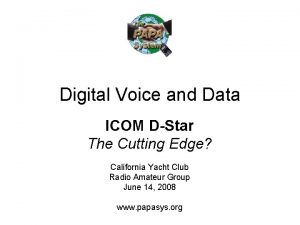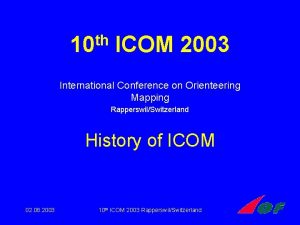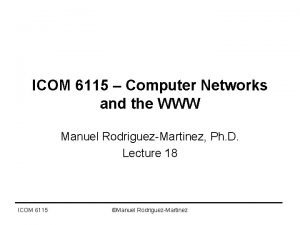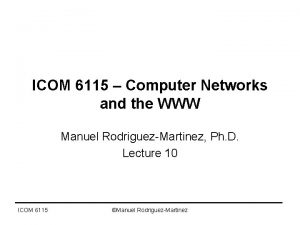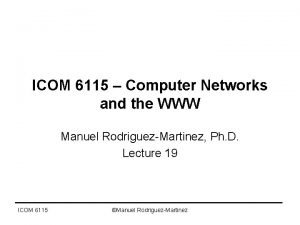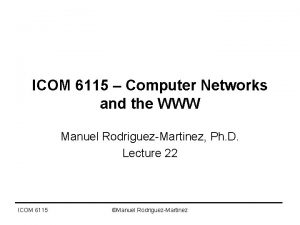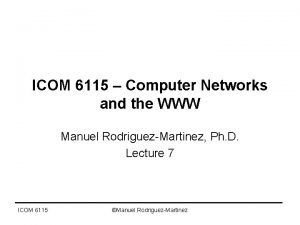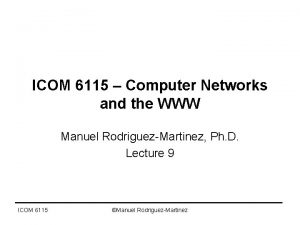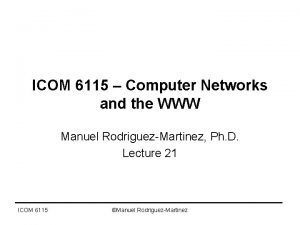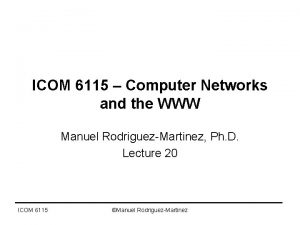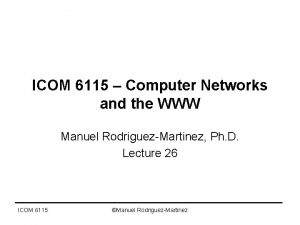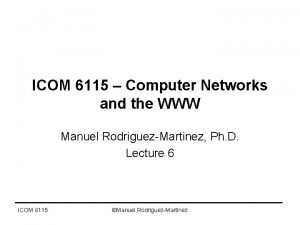ICOM 6115 Computer Networks and the WWW Manuel
















- Slides: 16

ICOM 6115 – Computer Networks and the WWW Manuel Rodriguez-Martinez, Ph. D. Lecture 4 ICOM 6115 ©Manuel Rodriguez-Martinez

Lecture Objectives • Understand Network Programming – Socket abstraction • Stream Socket • Datagram Socket – Networking Support in the programming language • Java – Operating Systems support for Networking – Implementation options for servers ICOM 6115 ©Manuel Rodriguez-Martinez

Network Programming • Client-server and P 2 P are the models to organize application – Architectural Framework • How do we actually move data between the components of the application? – Sockets – Provide abstraction of a file to perform I/O • Send data to receiver • Read data from sender ICOM 6115 ©Manuel Rodriguez-Martinez

The idea of OS File Application File “My. Letter. doc” Disk ICOM 6115 ©Manuel Rodriguez-Martinez

The OS File • Provides mechanism to read related blocks of bytes from disk – Hides where they are on disk • OS must keep track of this information – File System • Operations on files – Create, Open, Close, Read, Write • Need more sophistication: use streams – Another layer on top of files • Provides access to int, string, bytes, object, etc ICOM 6115 ©Manuel Rodriguez-Martinez

The Idea of Socket • See the networks as a cable to which the applications can connect. • Socket is the place where the application “plugs” itself to the network – Every app. is using a socket to send/receive • Associate a socket with two files – One for reading from socket – One for writing to socket ICOM 6115 ©Manuel Rodriguez-Martinez

Socket Abstraction Client IN I/O Files OUT IN Socket OUT Socket Network ICOM 6115 Server ©Manuel Rodriguez-Martinez

Communication between sockets Client Server IN IN OUT Socket Network ICOM 6115 OUT ©Manuel Rodriguez-Martinez

Types of Sockets • Stream Socket – Provide a reliable bytes stream between the end-points – Connection oriented • TCP • Datagram Socket – Provide an unreliable byte stream between the end-points – Connectionless • UDP ICOM 6115 ©Manuel Rodriguez-Martinez

Creating a Socket in Java • Client sockets – Destination host – Port number • Server Socket – Port number • Many other flags can be set • Sockets can be encrypted – SSL – Custom-made ICOM 6115 ©Manuel Rodriguez-Martinez

Example Client and Server apps • Basic Application – Get the Date • My. Server 1. java • My. Client 1. java • Another toy application – Get the Date or nick name of the machine – Illustrates the need for protocols ICOM 6115 ©Manuel Rodriguez-Martinez

Iterative Server Client Server Listen Queue OS ICOM 6115 ©Manuel Rodriguez-Martinez

Iterative Server • One server to handle multiple requests – Simple to implement – Take some time to service each request • Bottleneck if I/O is needed – Should be used only to service small requests • Time • Name of a computer – Typically used for connectionless services • Datagrams ICOM 6115 ©Manuel Rodriguez-Martinez

Concurrent Server Master Server ICOM 6115 Client Slave Server ©Manuel Rodriguez-Martinez

Concurrent Server • Multiple serves to handle multiple requests – Each client has its own server • Master server – receives initial request and forwards it to slaver server • Slave server is the actual entity that interacts with the client • Issues ICOM 6115 ©Manuel Rodriguez-Martinez

Concurrent Servers (Issues) • Issues – More complex to implement – Provides parallelism • Good for I/O intensive applications – Should be used to service large requests • HTTP • Database requests – Typically used for connection-oriented services • TCP Applications ICOM 6115 ©Manuel Rodriguez-Martinez
 Differences between virtual circuits and datagram networks
Differences between virtual circuits and datagram networks Backbone networks in computer networks
Backbone networks in computer networks Icom ic-2730a vs kenwood tm-v71a
Icom ic-2730a vs kenwood tm-v71a Papasys
Papasys Icom
Icom Icom model project management
Icom model project management Difference between intserv and diffserv
Difference between intserv and diffserv Error detection in computer networks
Error detection in computer networks Character stuffing example
Character stuffing example What is bit and byte stuffing? explain with example.
What is bit and byte stuffing? explain with example. Arp vs rarp
Arp vs rarp Analogue and digital transmission in computer networks
Analogue and digital transmission in computer networks Web and http in computer networks
Web and http in computer networks Computer networks and internets with internet applications
Computer networks and internets with internet applications What is crc in computer network
What is crc in computer network Protocols and standards in computer networks
Protocols and standards in computer networks Crc in computer networks
Crc in computer networks



